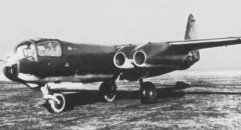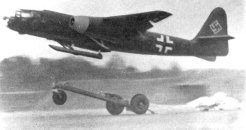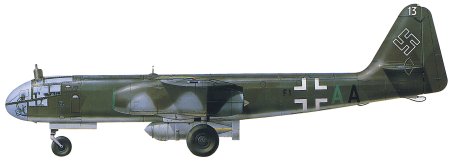
Arado Ar 234
The Arado-234 Blitz (Lighting) was the world’s first jet bomber and although less well known, it was one of the cutting-edge weapons of Nazi Germany which the Allies had not yet had an answer. It was the only jet bomber to be operational during the war and despite handicapped by fuel and material shortage, this aircraft went on to play significant roles on all European fronts during the closing months of the war.
The first reconnaissance mission was over the British Isles in September 1944. Using its speed, the Blitz easily evaded defending RAF fighters. Bombing raids of Allied supply lines began in December 1944, where several Arado 234 Blitz successfully completed their mission in Belgium. March 1945 saw several more Blitz attacks on the Remagen bridge across the Rhine, causing it to collapse.
This advanced aircraft would have caused the Allies significant problems, but it was a case of too little, too late to make any difference to the course of the war. By March 1945, just barely six months after the first sortie, all Blitz operations had ceased as the Third Reich collapsed under the force of advancing Allied armies. Despite the Allies having control of the skies, only one Arado-234 had ever been shot down, testimony of the uninterceptability of this aircraft.
Design work began in 1941 based on a Luftwaffe specification for a high-speed long-range jet reconnaissance aircraft. Power was provided by two Junkers Jumo turbojet, piloted by a single crew enclosed in a pressurized cockpit. In order to achieve the required range, early prototypes were fitted with a three-wheel trolley jettisoned during take-off. For landing, retractable skids were deployed, while outriggers under each engine nacelle prevented the wings from touching the ground. Later variants were redesigned to use conventional landing gears and pre-production models leading up to the operational Arado 234B-1 were fitted with ejection seat, autopilot and drop tanks.
A fully laden Arado-234 required up to 380 meters of runway to take-off. To improve performance, two Walter rocket-assisted take-off (RATO) units could be fitted under the wing. These RATO units were jettisoned after take-off, but frequent failure with the landing parachutes resulted in a number of RATO units being destroyed.
The final variant, the production model Arado 234B-2 was converted into a bomber. Fitted with a bombsight between the pilot’s feet, it could carry a bombload of up to 2,000 kgs in various configuration. Some aircraft were fitted with twin 20mm cannons remotely aimed by the pilot’s dive bombing periscope above the cockpit.
Other prototype designs existed by the end of the war. Among them was the four-engined Arado 234C built using BMW and Junkers engine. A partially complete swept wing design was also captured by the Allies which design was later copied by many western powers.
The Arado 234 enjoyed brief success where it scored many distinctions in the field of aviation. It was not only the world’s first jet bomber, but also the first combat aircraft to use RATO units and among the first to have cockpit pressurization, ejection seats and an autopilot system. The aircraft maneuvered well at high speeds, but as with all jet aircraft, it was awkward at low speeds. Another limitation was the Junkers powerplant which had a service life of only 25 hours. About 210 of this aircraft was captured by the Allies.
 |
 |
 |
| The prototype Arado 234C used four BMW 003A-1 powerplant. |
An early Arado 234 V1 prototype taking off from a three-wheel trolley. After jettison, a parachute would bring the trolley to a halt. |
Arado 234B with the periscope sight visible above the cockpit. It has a bomb payload of around 2 tons and was usually unstoppable. |
|
Arado Ar 234 (Technical Specification) |
| Role |
Single-seat twin-turbojet tactical reconnaissance bomber |
| Manufacturer |
Arado |
| Maximum Speed |
742 kmh (460 mph) |
| Maximum Range |
1,630 km (1,010 miles) |
| Ceiling |
10,000 meters (33,000 feet) |
Weight
Empty
Maximum Takeoff |
5,200 kg (11,440 lbs)
9,800 kg (21,560 lbs) |
Dimensions
Wingspan
Length
Height
Wing Area |
14.44 meters (46ft)
12.64 meters (41 ft)
4.29 meters (14 ft)
27.3 square meters (294 sq ft) |
| Engines |
Two Junkers Jumo 004B-1 Orkan turbojet engines which provides 8.8-kN (1,975-lbs thrust) |
| Armament |
Up to 1995 kgs (4,400 lbs) of bombs |
Photo Gallery
Click here to submit your photo
| Have A Passion For Aircraft? |
Subscribe to our 14 series FREE newsletter
delivered weekly on World War 2 Aircraft factfile... |
| NB:- We hate spam as much as you do, so your email address will NEVER be shared with or sold to anyone else. That's a Guarantee. |
|
|






